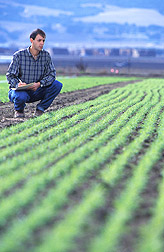This page has been archived and is being provided for reference purposes only. The page is no longer being updated, and therefore, links on the page may be invalid.
In Organic Cover Crops, More Seeds Means Fewer Weeds
By Ann PerryJanuary 25, 2010
Farmers cultivating organic produce often use winter cover crops to add soil organic matter, improve nutrient cycling and suppress weeds. Now these producers can optimize cover crop use by refining seeding strategies, thanks to work by an Agricultural Research Service (ARS) scientist.
In moderate climates, suppressing weeds in winter cover crops is important because weeds that grow throughout the year produce seed that can increase weeding costs in subsequent vegetable crops. ARS horticulturist Eric Brennan, at the U.S. Agricultural Research Station in Salinas, Calif., conducted studies comparing winter cover crop planting protocols in organic systems along California’s central coast.
Brennan looked at how seeding rates and planting patterns affected cover crop performance. He planted rye using three seeding rates: 80 pounds per acre, 160 pounds per acre and 240 pounds per acre. The seeds were either planted in a grid pattern that required driving a grain drill across fields twice, or in traditional rows. All seeding was carried out in October.
Brennan found that planting rye at higher seeding rates consistently improved early-to midseason rye biomass production and weed suppression. But he saw no consistent crop improvement from grid planting.
Brennan also studied seeding rates and planting patterns using a cover crop of legumes and oats. The seeds were planted at densities of 100, 200, and 300 pounds per acre and planted both in grids and traditional rows.
Results were similar to the rye cover crop results. As seeding rates increased, weed biomass production decreased from around 267 pounds per acre to less than 89 pounds per acre. In addition, planting patterns had no effect on cover crop yield or weed suppression.
Brennan’s findings suggest that increased seeding rates could provide organic producers with a cost-effective weed control strategy. However, planting in a grid pattern would probably not consistently boost the benefits of cover crops—and since it would require two passes through the field, grid planting would likely double dust production, fuel use, planting time and labor.
The research was published in the Agronomy Journal.
ARS is the principal intramural scientific research agency of the U.S. Department of Agriculture.

